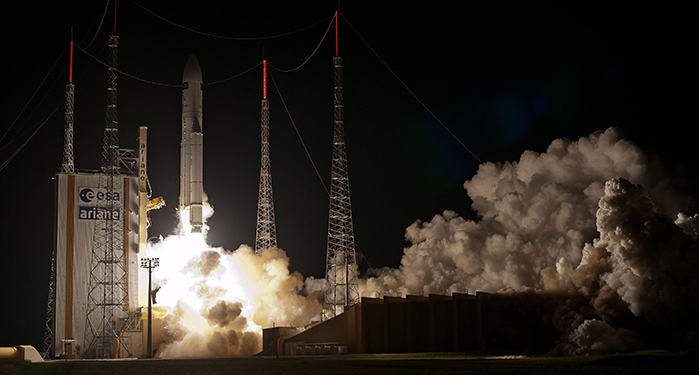
The European Space Agency’s (ESA) fifth and final Automated Transfer Vehicle (ATV-5) is presently en-route to the International Space Station (ISS), following a rousing launch atop a mighty Ariane 5 booster from the Guiana Space Centre in Kourou, French Guiana, on Tuesday, 29 July. Liftoff of the two-stage Ariane 5 occurred at 8:47:46 p.m. GFT (7:47:46 p.m. EDT) and delivered ATV-5—which is named in honor of the Belgian priest and astronomer Georges Lemaître (1894-1966)—on a two-week journey to the space station. It will dock automatically at the aft longitudinal port of the Zvezda module on 12 August and will remain in place until late January 2015, bringing about 5,730 pounds (2,600 kg) of dry cargo to the ISS and its incumbent Expedition 40 crew.
As detailed in AmericaSpace’s ATV-5 preview article, the mission was delayed by several days to permit what Paris, France-based launch services provider Arianespace described as “complementary verifications on the Ariane 5 ES launch system.” A Flight Readiness Review for Mission VA-219—the 218th overall flight by a member of the Arianespace’s rocket family, since the maiden voyage of an Ariane 1 in December 1979—took place Sunday, 27 July, and the 171-foot-tall (52-meter) booster was rolled out to the ELA-3 (Ensemble de Lancement Ariane) launch zone Monday. Following the arrival of the vehicle at the pad, Arianespace engineers set to work establishing electrical, fluid, and other connections. At about 9:30 a.m. GFT (8:30 a.m. EDT) Tuesday, the 11.5-hour countdown formally got underway, when all controllers were called to stations. According to AmericaSpace’s Launch Tracker, the weather forecast in the tiny French overseas region called for clear skies, good conditions, and winds of about 12 mph (20 km/h).
Electrical systems checks on the Ariane 5 rocket were concluded by early afternoon, ahead of the process to load 260,000 pounds (118,000 kg) of liquid oxygen and 50,000 pounds (22,700 kg) of liquid hydrogen into the first stage to feed the French-built Vulcain-2 engine. By 5:30 p.m. GFT (4:30 p.m. EDT), the process had entered “Replenishment Mode,” with all tanks full and transitioned to “topping,” whereby all boiled-off cryogenics were rapidly replenished until close to launch time. At 7:35 p.m. GFT (6:35 p.m. EDT), with just over 70 minutes remaining before the planned T-0, links between ground tracking systems, telemetry, and command systems—including, significantly, the Flight Termination System (FTS), which would destroy the Ariane 5 in the event of a major accident during ascent—were extensively tested.
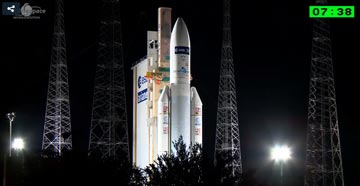
At 8:40 p.m. GFT (7:40 p.m. EDT), at T-7 minutes, the Synchronized Launch Sequence got underway, with the remainder of the countdown overseen by a pair of redundant computers at the ELA-3 launch complex, together with the vehicle’s on-board computers. The propellant tanks were pressurized for flight at T-4 minutes, and the Ariane 5 transitioned to its internal power supplies. At T-2 minutes, Arianespace reported a complete “Green Panel,” indicating that all stations had declared themselves “Go for Launch” and ready to support the mission. With liftoff precisely timed to occur at 8:47:46 p.m. GFT (7:47:46 p.m. EDT), the final seconds encompassed a flurry of automatic activity.
At T-38 seconds, the deluge system was activated, flooding the ELA-3 pad surface and flame trench with water to reduce reflected energy, as well as helping to prevent structural damage and ensuring proper sound suppression protection at liftoff. Shortly afterward, the Vulcain-2 engine was chilled down in order to condition its propellant lines, prior to the ignition sequence, and the cryogenic oxygen and hydrogen umbilical was retracted. In the final seconds, the automated systems aboard the rocket assumed primary command of all critical functions and the guidance system was unlocked to Flight Mode.
Precisely on time, at 8:47:38 p.m. GFT (7:47:38 p.m. EDT), the Vulcain-2 roared to life, producing 300,000 pounds (136,000 kg) of propulsive yield. Although this was T-0, the actual liftoff command did not occur for another 7.5 seconds, as standard computer-commanded health checks of the engine’s performance were undertaken. At T+7.5 seconds, with all confirmed to be well, the Ariane 5’s two side-mounted, solid-fueled boosters were ignited. Each of these powerhouses punched out 1.4 million pounds (635,000 kg) of thrust, together generating 92 percent of the impetus to get the rocket off the pad, and 8:47:46 p.m. GFT (7:47:46 p.m. EDT) Mission VA-219 was committed to flight.
The stack rose vertically for about five seconds, after which the two computers inside the Vehicle Equipment Bay (VEB) within its second stage initiated a combined pitch and roll program maneuver, actively rotating the vehicle onto a north-easterly trajectory and placing it onto the correct flight azimuth to insert ATV-5 into a 51.6-degree-inclined orbit. One minute into the ascent, the vehicle went supersonic and passed “Max Q,” the period of maximum aerodynamic stress on the airframe. “During this first phase of the rocket’s flight,” noted AmericaSpace’s Launch Tracker, “the attitude of the rocket and boosters’ axis is aligned … to ensure that it remains parallel to the velocity vector to minimize aerodynamic pressures during the ascent through the densest part of the atmosphere.” The twin boosters were jettisoned at T+142 seconds, at about 8:50 p.m. GFT (7:50 p.m. EDT), parachuting into the Atlantic Ocean about 300 miles (480 km) northeast of Kourou. Meanwhile, Ariane 5 had by now attained a velocity of over 1,200 mph (1,900 km/h) and continued to climb under the impulse of its Vulcain-2 engine.
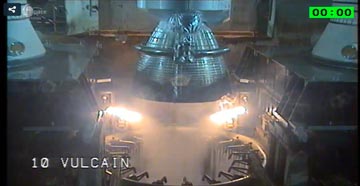
Finally, 3.5 minutes into the ascent—at 8:51:11 p.m. GFT (7:51:11 p.m. EDT)—the bullet-like payload fairing was detached, exposing ATV-5 to the space environment for the first time. “This is achieved by means of two separation systems,” it was explained by the Tracker. “A horizontal one, made of a pyrotechnical expansion tube which connects the fairing to the payload equipment bay, and a vertical one that consists of a pyrotechnic cord, located close to the plane joining the two half-shells of the fairing.”
Shutdown of the Vulcain-2 took place about eight minutes and 53 seconds after launch, and the first stage (also known as the “cryotechnic main stage”) descended to a splashdown off the coast of western Africa, in the Gulf of Guinea. Meanwhile, the second stage—powered by a restartable, 6,100-pound-thrust (2,770-kg) Aestus engine—ignited at 8:56:38 p.m. GFT (7:56:38 p.m. EDT) to pick up the baton for the final push into orbit. By now, the rocket was over 105 miles (170 km) high and traveling at more than 4,300 mph (6,900 km/h). Fueled with unsymmetrical dimethyl hydrazine and nitrogen tetroxide, the Aestus burned for about eight minutes, then shut down at 9:04:50 p.m. GFT (8:04:50 p.m. EDT), for an extended period of coasting, ahead of a second, 55-second burn to circularize ATV-5’s orbit at about 150 miles (240 km). This second burn commenced at 9:46:38 p.m. GFT (8:46:38 p.m. EDT), and, after its second shutdown, the second stage and ATV-5 parted company at T+64 minutes after liftoff. At the point of spacecraft separation, ATV-5 was traveling to the southeast of New Zealand.
Named in honor of the Belgian priest and astronomer Georges Lemaître (1894-1966), the ATV-5 spacecraft will deliver about 5,730 pounds (2,600 kg) of dry cargo to the ISS. With a total weight of 40,600 pounds (18,415 kg), this spacecraft represented the largest and heaviest payload ever placed into orbit by an Ariane 5. Measuring 34 feet (10.4 meters) long and 15 feet (4.6 meters) wide, ATV-5 includes the Integrated Cargo Carrier for pressurized payloads, together with a Service Module for its computers, gyroscopes, navigation and control subsystems, electrical power and communications hardware, and a propulsion module for rendezvous and periodic “reboosts” of the space station’s orbit. The ATV has the capacity to deliver 16,000 pounds (7,250 kg) of equipment and supplies into low-Earth orbit, including up to 12,100 pounds (5,500 kg) of dry cargo, up to 1,850 pounds (840 kg) of water, up to 220 pounds (100 kg) of pressurized gases, and up to 10,400 pounds (4,700 kg) of propellants. Whilst ATV-5 is incapable of returning items intact to Earth—and instead burns up in Earth’s atmosphere at the end of each mission—it can remain docked to the ISS for up to six months, far longer than other visiting vehicles, such as Japan’s H-II Transfer Vehicle (HTV), SpaceX’s Dragon, or Orbital Sciences’ Cygnus. Unlike those craft, the ATV is not designed to berth at the U.S. segment of the station, but rather to dock automatically at the Russian “end.” Consequently, it is outfitted with a Progress-type docking mechanism.
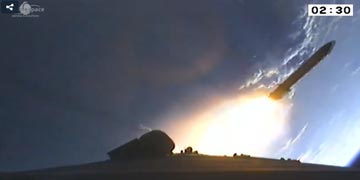
Tuesday’s Mission VA-219 marked the 74th flight by an Ariane 5, which first flew in June 1996, and the 218th overall flight by a member of Arianespace’s rocket family since the maiden voyage of an Ariane 1, way back in December 1979. To date, Ariane 5 has proven an exceptionally reliable vehicle, having enjoyed 69 wholly successful missions. Only two have failed outright and two others have been classified as partial failures. The launch of ATV-5 marked the third Ariane 5 mission of 2014, following hard on the heels of VA-217, which lofted the Athena-Fidus and ABS-2 satellites in early February and VA-216, which delivered the Astra 5B and Amazonas 4A satellites in late March. Another mission, VA-218, was scheduled to fly in early June, but has met with extensive delay, until at least September, due to the need for “additional verifications” of its Optus-10 satellite payload.
At the time of writing, Georges Lemaître—or, at least, his mechanized namesake—is in independent flight and will spend the next two weeks executing a complex ballet of orbit-raising maneuvers to gradually close the distance to the ISS, in readiness for an automatic docking at the aft longitudinal port of the Zvezda module on 12 August. It will spend more than five months at the ISS, during which time it will be unloaded and will perform periodic “reboosts” of the station’s orbital altitude.
Following its scheduled departure on 25 January 2015, it will give a unique perspective, from the inside, of a vehicle’s destructive dive into the atmosphere. The ATV Break-Up Camera (BUC) and a spherical Re-entry SatCom capsule were developed in just nine months and will provide for the transmission of infrared images during the fiery destruction of the main body of the spacecraft. The experiment is described as giving “as full a picture as possible of the conditions inside the vehicle as it breaks up.” Bolted to a rack within the ATV, the camera itself will eventually burn up, but imagery of its final 20 seconds will be passed to the SatCom, which is protected by a ceramic heat shield. Break-up of ATV-5 is anticipated at an altitude of around 43-50 miles (70-80 km), after which the SatCom will descend at a velocity of about 15,660 mph (25,200 km/h). “The fall will generate high-temperature plasma around it, but signals from its omni-directional antenna should be able to make it through any gap in the plasma to the rear,” said Neil Murray, who leads the ESA project. Additionally, signals will continue after the SatCom has decelerated to an altitude of about 25 miles (40 km) levels, where a plasma “sheath” is no longer formed, by which time it will become visible to Iridium satellite relays.
ATV-5 will be the fifth and final mission by the ESA-provided cargo ship, which first flew in March 2008. The ATV-1 spacecraft was named for Jules Verne, the 19th-century French science fiction writer and visionary and spent six months at the ISS, before it was undocked and returned to a destructive re-entry the following September. Next came ATV-2, which paid homage to the 17th-century German astronomer Johannes Kepler, and which flew from February-June 2011. This was followed by ATV-3, which honored Italian physicist Edoardo Amaldi and flew from March-October 2012. Most recently, ATV-4 was launched in June 2013, named for the great physicist Albert Einstein, which remained in orbit until November.
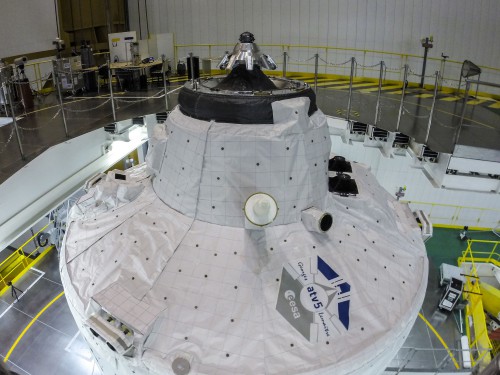
The selection by ESA of Lemaître’s name for ATV-5 came in February 2012 and was described as continuing “the tradition of drawing on great European visionaries to reflect Europe’s deep roots in science, technology and culture.” Georges Henri Joseph Édouard Lemaître, born in Charleroi, Belgium, on 17 July 1894, is today famous for having first proposed the theory of the expansion of the Universe and for deriving what we now known as “Hubble’s Law.” Lemaître’s research was published in 1927, two years ahead of the work of U.S. astronomer Edwin P. Hubble.
After a classical education at a Jesuit school, Lemaître entered the Université Catholique de Louvain to study civil engineering, but his work was stalled by the Great War. After serving Belgium as an army artillery officer, he returned to his studies, focusing on physics and mathematics and preparing for the priesthood. Upon receipt of his doctorate in 1920 and ordination as a priest in 1923, Lemaître entered the University of Cambridge, England, as a graduate student in astronomy, and later worked at Harvard College Observatory in Cambridge, Mass. Returning to Belgium in 1925, he became a part-time lecturer at the Université Catholique de Louvain and it was whilst there that he began work on the report which would earn him worldwide renown. In 1927, in the Annals of the Scientific Society of Brussels, Lemaître wrote of “A homogeneous Universe of constant mass and growing radius, accounting for the radial velocity of extragalactic nebulae.” Little read outside of his native Belgium, it was not until 1931 that the work was translated into English.
The famed theoretical physicist Albert Einstein is said to have regarded Lemaître’s ideas of an expanding universe with a measure of scorn, at first, to which the Belgian responded: “Your calculations are correct, but your physics is atrocious!” Invited to speak at a meeting of the British Association in London, Lemaître explained his conviction that the universe expanded from an initial point—which he labeled “The Primeval Atom”—and his work was subsequently published in the journal Nature. He referred to it as a “Cosmic Egg exploding at the moment of creation,” but in years to come it would become the cornerstone of what is today dubbed “The Big Bang.”
In recognition of his work, Lemaître received the Francqui Prize—Belgium’s highest scientific award—from King Léopold III. It was an award for which he had been nominated by Einstein and also by his mentor, the English astrophysicist Arthur Eddington. In 1936, he was elected a member of the Pontifical Academy of Sciences, of which he subsequently became president. Opposed to the mixture of science and religion, Lemaître disagreed with Pope Pius XII’s proclamation that his work validated the notion of Creationism. Both Lemaître and the pope’s scientific advisor, Daniel O’Connell, successfully persuaded Pius XII not to publicly mention Creationism again in a public setting. As head of the Pontifical Academy of Sciences, he continued his teaching workload, albeit in a reduced capacity, until shortly before his death. Lemaître died in Leuven, Belgium, on 20 June 1966, aged 71.
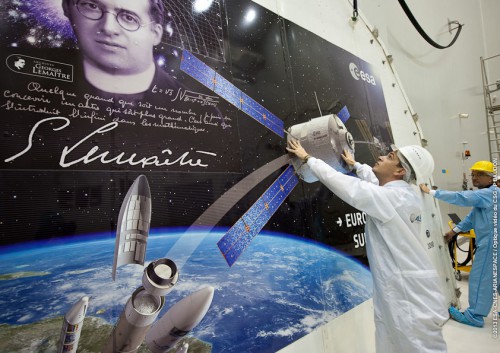
Early in 2012, ESA announced that it intended to shut down its ATV production line after the ATV-5 Georges Lemaître mission. It was specifically indicated that “a significant obsolescence problem” existed at equipment and component levels, limiting the desire or ability to reopen the line. Costing about $600 million, per unit, to build, the ATV operated as part of a “barter” arrangement between ESA and its ISS partners, covering its operating costs at the space station until 2017. A further $600 million investment was needed to cover the 2017-2020 timeframe and Germany apparently favored participation in the design of the Service Module for NASA’s Orion spacecraft. In November 2012, it was reported that ESA was prepared to provide an ATV-based Service Module as “payment in kind” for continued involvement with the ISS through the end of the decade, and, in early 2013, it was formally announced that Europe would indeed build the Service Module for Orion’s first Exploration Mission (EM-1), currently scheduled to launch atop the first Space Launch System (SLS) heavy-lift booster in December 2017.
Want to keep up-to-date with all things space? Be sure to “Like” AmericaSpace on Facebook and follow us on Twitter: @AmericaSpace



